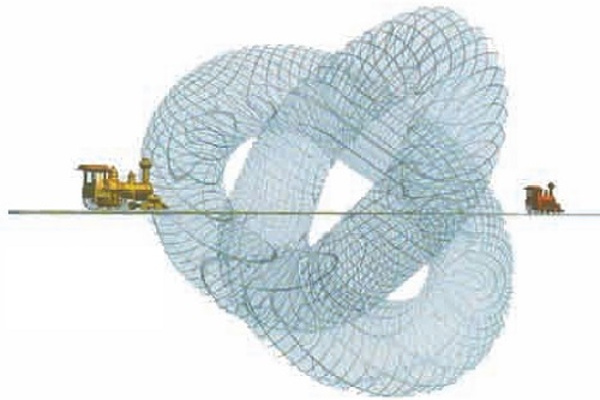The theory of time
Hawking's scientist synthesized and developed the most likely time model, from the theory of Newton and Einstein.

Newton's time separated from space, like a straight line from the past to the future.(Photo: Universe in a nutshell / Stephen Hawking)
In the book " Mathematical Principles " published in 1687, Newton describes time and space as a backdrop for events taking place, and time cannot affect those events.
Newton's time is linear , as a straight line extends from the past to the present . However, if that means the universe must be created at a time, and why wait so long, almost endless until that time. In other words, "What did God do before creating the universe? " Hawking wrote.
In particular, if time is linear, why does the universe in the universe not reach thermal equilibrium, with the temperature of everything being the same? For example, put a cup of hot water in the room, to a point where the temperature of the glass of water will be equal to the room temperature. This is the Hawking problem posed in the book " The Universe in a Chestnut Shell " when talking about Newton's time.
According to Immanuel Kant, a German philosopher, this is " an antinomy of pure reason" and cannot be answered. However, considering Einstein's general theory of relativity, combining time with three dimensions of space into a so-called " spacetime " , these questions will be resolved.
In Einstein 's theory, no time is separate from the events that take place, but it actually participates in those events. Any object with a mass bends the space around it, causing a gravitational effect . It is possible to visualize this property as a ball placed on a rubber cushion that symbolizes spacetime. Due to its weight, the ball will sink "space " around it. It is not possible to warp space without altering the time.
Thus, according to general relativity, no time and the universe are attached to each other . Hawking also acknowledges in his book, time "has a beginning and an end. The question of what happened before the start time and what will happen after the end time is meaningless. because at that time it was not determined. "

Time is pear shaped.(Photo: Universe in a nutshell / Stephen Hawking)
Since then, Hawking has argued that " time must have a shape" . He argued that not only the masses of objects bent over time , but also energy contributed. Spacetime bending energy causes light rays to follow the curve and approach each other.
Imagine we have a light cone, in which the observer stands at the top of the cone observing the past (since light from distant events in the universe takes time in many light years to reach people. observe, so in fact, the person is looking at the past). The more under the cone, the more observers will see galaxies at very early times of the universe.
However, scientists have proved that the universe is expanding , meaning that at first everything must be very close together in a place of great density. So the observer will see a font of microwave background spread to along the light cone.
Experiment has confirmed this to be true. Measurements have detected a characteristic radiation spectrum for the temperature of 2.7K (270 degrees Celsius) that reaches the Earth, meaning " radiation needs to come from areas where matter scatters microwave" , follow Hawking.
From these bases, Hawking concluded that light from the past transmitted to Earth in light cones was once bent by a huge amount of matter. It is large enough to bend light rays converging together at a single point.
This is the singularity, where the big bang Big Bang gives birth to the present universe. Hawking thinks this is also the starting point. Thus, the time is shaped like a pear, bulging in the middle and baby again at the ends.
Also according to Hawking, time will end when "stars or galaxies collapse under their own gravity to form black holes."
- February 12: Charles Darwin - Theory of evolution and natural selection
- What is chaos theory?
- Watching the clock for 14 years is a way to prove Einstein's theory
- Time travel is a fantasy or quite realistic?
- Why does the new cosmic theory make Stephen Hawking angry?
- Harmless thought, but some conspiracy theories can be deadly
- Scientists have found a way to
- Time travel is real, this is the person holding this extraordinary record
- Stephen Hawking has just signed a letter to protect the doctrine of the origin of the universe
- Living on tall buildings will grow faster
- The secret of the connection between Albert Einstein's theory and the devil
- These are the reasons why we should believe that we live in the Multiverse system
 'Fine laughs' - Scary and painful torture in ancient times
'Fine laughs' - Scary and painful torture in ancient times The sequence of numbers 142857 of the Egyptian pyramids is known as the strangest number in the world - Why?
The sequence of numbers 142857 of the Egyptian pyramids is known as the strangest number in the world - Why? History of the iron
History of the iron What is alum?
What is alum?